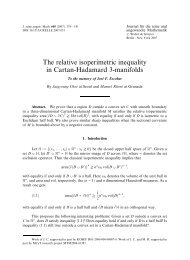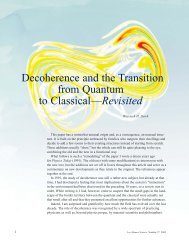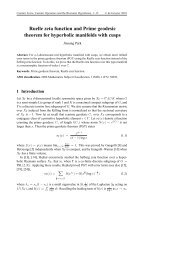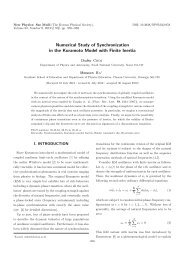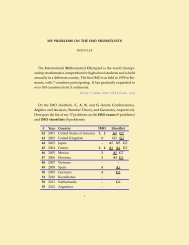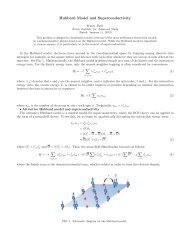A Quantum Kirwan Map: Bubbling and Fredholm Theory for ... - KIAS
A Quantum Kirwan Map: Bubbling and Fredholm Theory for ... - KIAS
A Quantum Kirwan Map: Bubbling and Fredholm Theory for ... - KIAS
You also want an ePaper? Increase the reach of your titles
YUMPU automatically turns print PDFs into web optimized ePapers that Google loves.
2.6. SOFT RESCALING 47Here the norm | · | 0 is with respect to the st<strong>and</strong>ard metric on S 1 ∼ = R/(2πZ), <strong>and</strong>we used the fact that <strong>for</strong> every ϕ ∈ g ∗ ,|ϕ| op ≤ |ϕ| := √ ϕ(ξ)where ξ ∈ g is determined by 〈ξ, ·〉 g = ϕ. We fix s ∈ [ log 2,log(R/r)/2 ) . Recalling(2.66), we have∫E(s) = e 2s0 e w (e s0+it )dtds 0 .Σ sCombining this with (2.70,2.71), it follows that(2.72) −A ( ι ∗ −s+log R ˜w ) + A ( ι ∗ s+log r ˜w ) ≤ − 1 d2 − ε ds E(s).Using (2.69), the hypotheses of Proposition 83 are satisfied with K replaced by K ′ .Applying that result, we haveE(s) = −A ( ι ∗ −s+log R ˜w ) + A ( ι ∗ s+log r ˜w ) .Combining this with (2.72), inequality (2.67) follows. This proves the claim.By the claim the derivative of the function[log 2, log ( ))Rr∋ s ↦→ E(s)e (2−ε)s2is non-positive, <strong>and</strong> hence this function is non-increasing. Inequality (2.61) follows.We prove (2.62). Let z ∈ A(4r, √ rR). Using (2.60) <strong>and</strong> the fact E 0 ≤ Ẽ0, itfollows from Lemma 72 (with r replaced by |z|/2) that(2.73) e w (z) ≤ 32 ( )π|z| 2 E w,B |z| (z) .2We define a := |z|/(2r). Then a ≥ 2 <strong>and</strong> B |z|/2 (z) is contained in A(ar,a −1 R).There<strong>for</strong>e, by (2.61) we haveE ( w,B |z| (z) ) ≤ 16r 2−ε |z| −2+ε E(w).2Combining this with (2.73) <strong>and</strong> the fact |d A u|(z) ≤ √ 2e w (z), it follows that(2.74) |d A u(z)v| ≤ Cr 1− ε 2 |z|−2+ ε 2√E(w)|v|, ∀z ∈ A(4r,√rR), v ∈ C.where C := 32/ √ π. A similar argument shows that(2.75) |d A u(z)v| ≤ CR −1+ ε 2 |z|− ε 2√E(w)|v|, ∀z ∈ A(√rR,R/4).Let now a ≥ 4 <strong>and</strong> z,z ′ ∈ A(ar,a −1 R). Assume that ε ≤ 1. (This is no realrestriction.) We define γ : [0,1] → C to be the radial path of constant speed,such that γ(0) = z <strong>and</strong> |γ(1)| = |z ′ |. Furthermore, we choose an angular pathγ ′ : [0,1] → C of constant speed, such that γ ′ (0) = γ(1), γ ′ (1) = z ′ , <strong>and</strong> γ ′ hasminimal length among such paths. (See Figure 4.)Consider the “twisted length” of γ ∗ (A,u), given by∫ 10∣ dA u ˙γ(t) ∣ dt.It follows from (2.74,2.75) <strong>and</strong> the fact ε ≤ 1, that this length is bounded aboveby 4C √ E(w)a −1+ε/2 . Similarly, it follows that the “twisted length” of γ ′∗ (A,u)□



